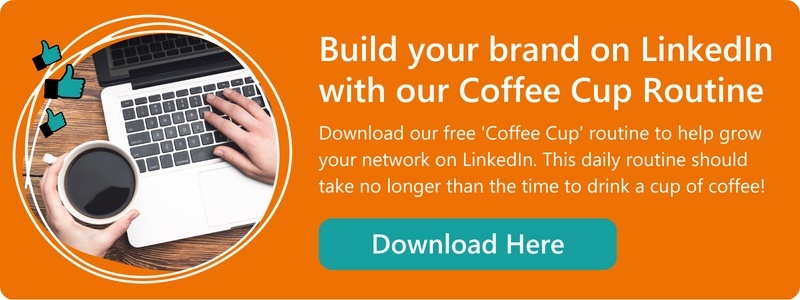
Using Sales Navigator can dramatically improve your ability to connect with prospects on LinkedIn.
That’s why, in this third and final part of our guide on social selling for BDRs and BDMs, we’re going to explore how you can get the most out of Sales Navigator, and build a daily LinkedIn habit.
Build Relationships
Building relationships is a key part of becoming a thought leader on LinkedIn. Some of the ways you can do this include:
- Use Sales Navigator to identify and save prospects
- Identify TeamLink and mutual connections to open the door
- Use Smart Links to create a content hub and identify the buyer cycle
- Join relevant LinkedIn groups to extend your reach
- Find and build relationships with relevant influencers
- Source and share content regularly (follow hashtags, sign up for Google Alerts, etc)
- Use InMails to start conversations and invite people to webinars
Recognise The Milestones
Prospecting leads to connections, which leads to conversions, and ultimately, to conversations.
Reps focused on new business, who exceeded their quotas, sent 148% more connection requests more than their peers, according to LinkedIn.
You can use Sales Navigator to develop new business by supporting existing accounts with strategic customer engagement activities that enhance relationships.
You can also develop new business opportunities through effective account research/prospecting relevant to your Market/Business sector responsibility (we suggest saving at least 15 accounts).
And you can target a high number of people from different accounts, regionally and globally (save at least four leads per account).
Identify Prospect Accounts And Leads
Salespeople focused on new business who exceed their quotas perform 52% more people searches each month. So, you want to be making the most of Sales Navigator filters to really focus your search on areas like:
- Regions of interest
- Relevant industries
- High-growth accounts
- Active leads
Sales Navigator will show you your 1st degree connections – people who are already a part of your network. This will allow you to see how many mutual connections you have.
If the connection hasn’t restricted how their network is viewed, you can search within it. You can also filter results by criteria such as location and current companies.
TeamLink allows you to view your team’s connections, even if you’re not connected to a particular colleague. This can help with introductions if they happen to be connected to someone you’d like to speak to.
View a 1st degree connection within your prospect list and select Mutual Connections on their profile. Then, de-select 1st degree connections in the drop down and focus on 2nd and 3rd degree connections. You can also filter here by location and current companies.
Don’t forget to save your leads and get automatic updates. You can set alerts to be informed about leads and new people in the roles you’ve defined (such as a job change, company news, etc). You can also set up searches for leads among competitors, too!
Search allows you to use multiple keywords with “AND”, “OR”, or “NOT” to create more in-depth searches. This tool will help you create your search string.
Utilise TeamLink And Mutual Connections
B2B buyers are five times more likely to engage when outreach is done through a mutual connection.
It also helps to:
- Focus on active prospects
- Identify common interests
- Consider your best path. Is it:
- TeamLink introduction?
- Mutual connection?
- As a last resort – direct outreach?
Introductions via your existing network
Underneath someone’s name on the search results, it will give you the option to message them. Click that to start a conversation with them.
Always write to your connection using a warm tone and make your point quickly and clearly. Be specific about the value your intended contact will receive from the introduction and show your appreciation for their help.
Use InMail to open a conversation
According to LinkedIn, 89% say they’re more likely to consider products and services from sales reps who understand their business’s needs, role, and who take a personalised approach.
Personalised InMails can be used to share new research/articles, invite prospects to a webinar, ask for a referral to someone, or share a Smart Link you’ve created.
Use connection requests for direct contact
When sending connection requests, include some text so that you’re not just a random person inviting someone to connect. Identify your common connection early on, and state how you’re helping solve issues.
Also, explain why you’re reaching out and suggest connecting. And always tailor your message.
You could be really specific and invite them to an event, or start with a simple request and follow up with a private message on “potential further discussion”.
When you’re at events or travelling, you can use the app to connect.
Get into the habit of inviting people immediately after meeting them – a timely connection request is likely to be accepted.
Once someone is in your network, you can digitally nurture that connection with your thought leadership content.
Smart Links to identify the buying circle
There’s an average of 6.8 people involved in every B2B purchase decision, according to CEO.
Smart Links help you to package up relevant content into one link. It will also show you how buyers are engaging and uncover the wider buyer committee within a business.
Consider including things like:
- Product information
- Sales documentation
- Webinar resources
- Educational resources
Participate in LinkedIn groups to grow reach
You’re 70% more likely to get an appointment if you cite a common LinkedIn group. So, make sure you’re joining those relevant groups we mentioned earlier!
You can use keyword searches in LinkedIn to find them. Don’t forget to consider the number of members and the location of the group.
Engage with relevant influencers
49% of people sale they rely on recommendations from influencers when making B2B purchase decisions.
Look for relevant influencers in your industry/field, and engage with their content. You could do this by sharing an article they wrote, tagging them in your post, or inviting them to connect.
You can also engage with the posts of your decision makers. Like their content, comment on posts, but don’t be too sales centric.
Also consider re-sharing their content with your network if it’s relevant. Avoid over-engagement, though!
Create habits with daily tasks
Salespeople focused on new business who exceed quota make 39% more engagements each month. This includes liking, commenting, and resharing.
Here’s how we suggest approaching LinkedIn. Each of these tasks takes just a few minutes.
Day 1
Search and save two or three accounts.
Day 2
Engage with leads and accounts, and share content.
Day 3
Create a Smart Link.
Day 4
Engage and share content with groups and influencers.
Day 5
Send two InMails and/or connect with someone.
Conclusion
Always set yourself a goal for what you want to get out of LinkedIn. Consider how many people you want to contact and what leads you want to follow up with.
Also, engage on a personal level – social selling is a one-to-one activity. Make sure you come across as authentic – this is easier and builds up trust faster.
Add value to your audience by passing on resources that can help educate the buyer, but don’t forget to listen and learn from what customers share and comment on, too. All these activities will help you to build trust and establish yourself as an expert.
While winging it may sound tempting, without defined goals, it’s a lot harder to measure success.
Don’t broadcast business content too much, either. This will put people off and make them less likely to engage, causing the algorithm to show your content to fewer people.
This means don’t sell too early, either. Selling too early can damage your credibility, just like being fake can. You want to foster genuine relationships with people.
Remember to listen first and share content second. Then, you can focus on connecting and conversing.
